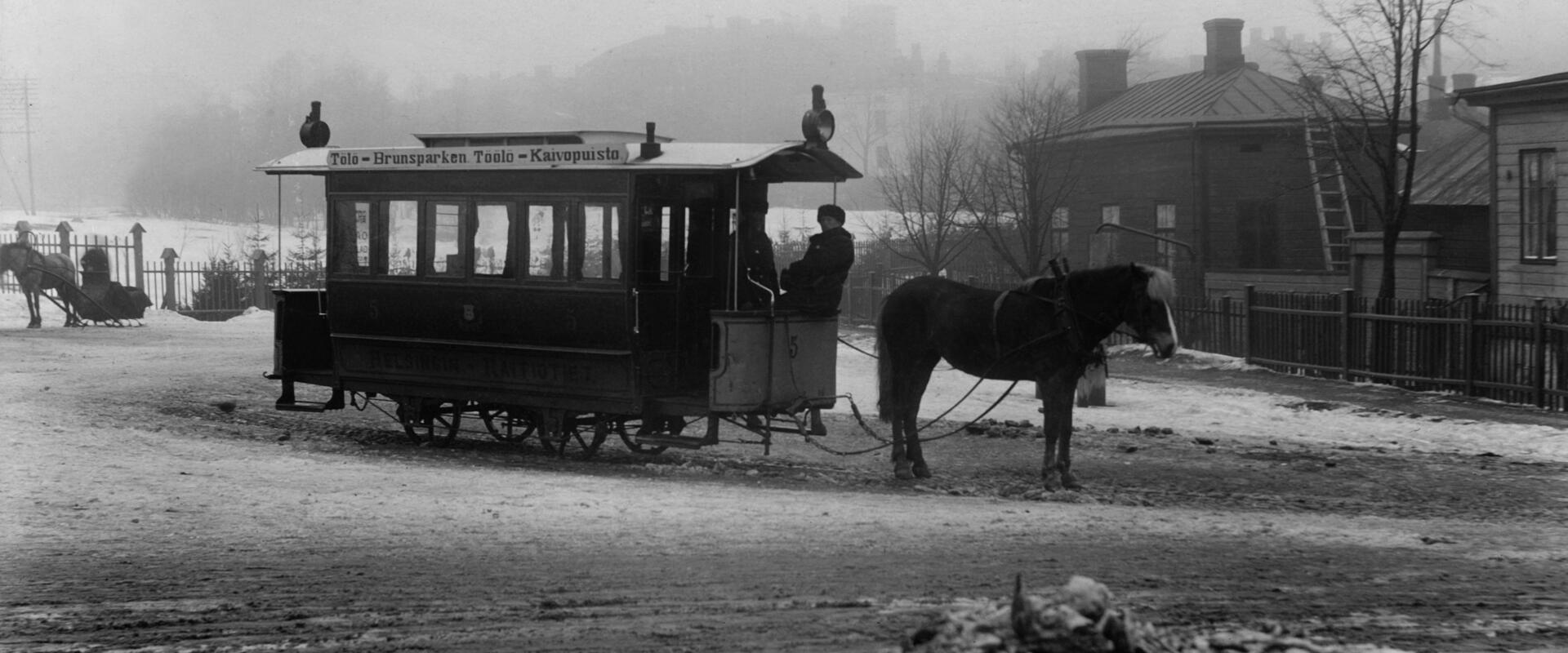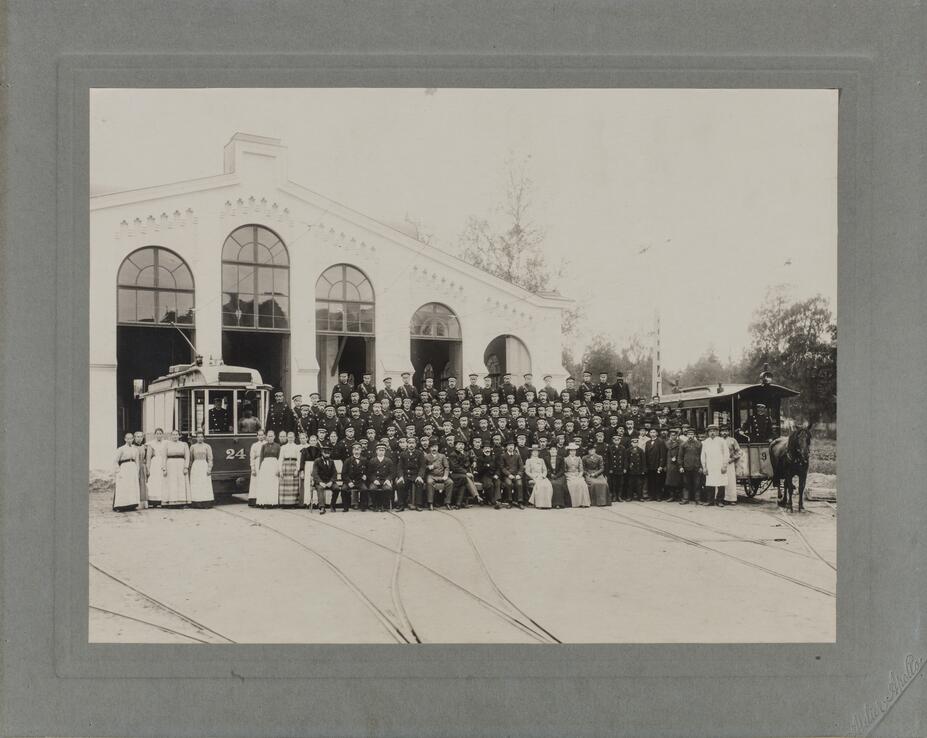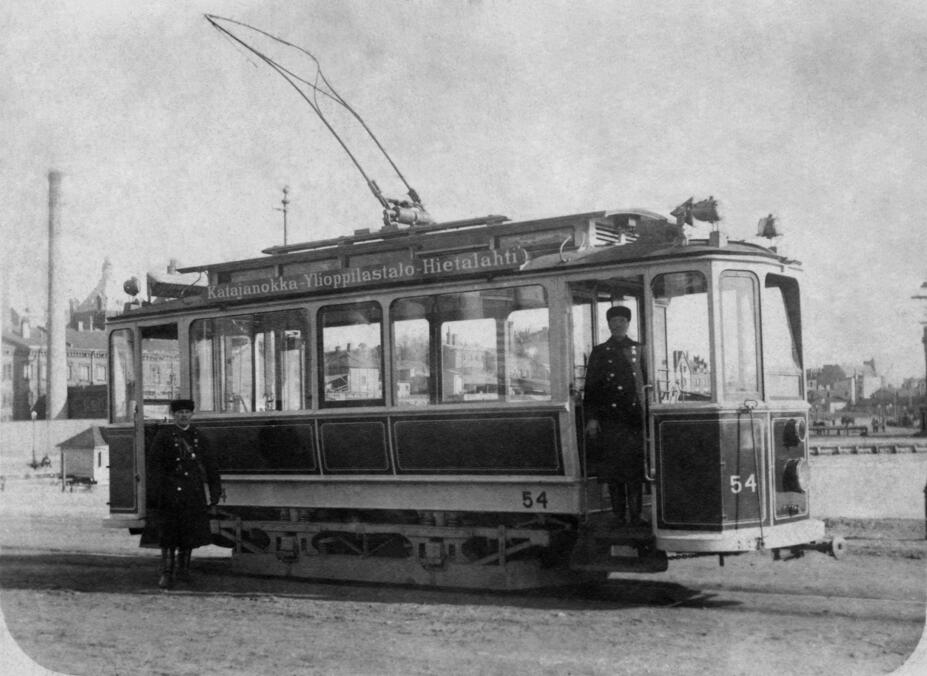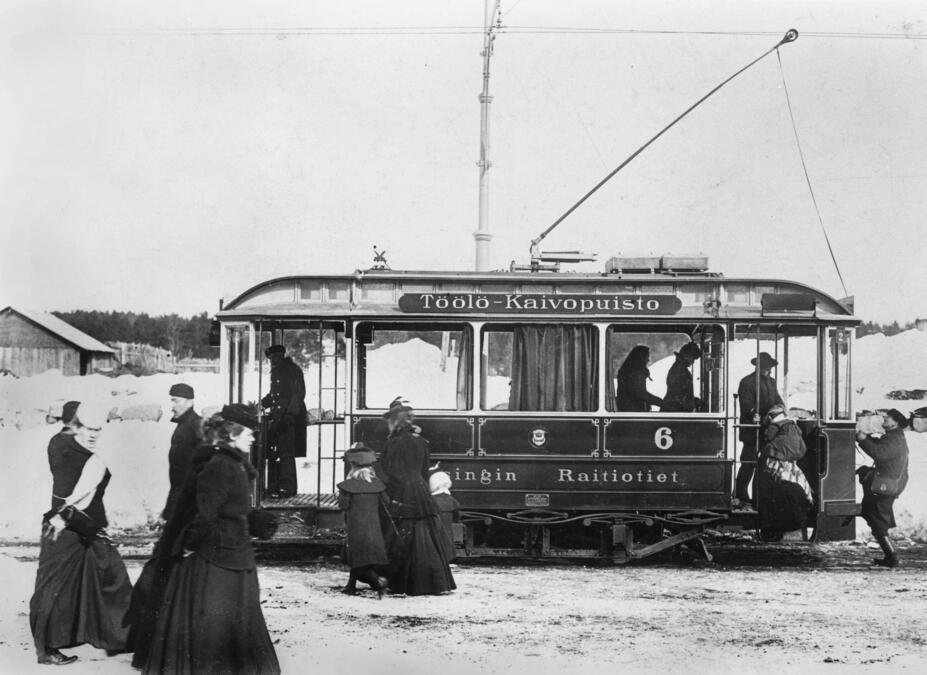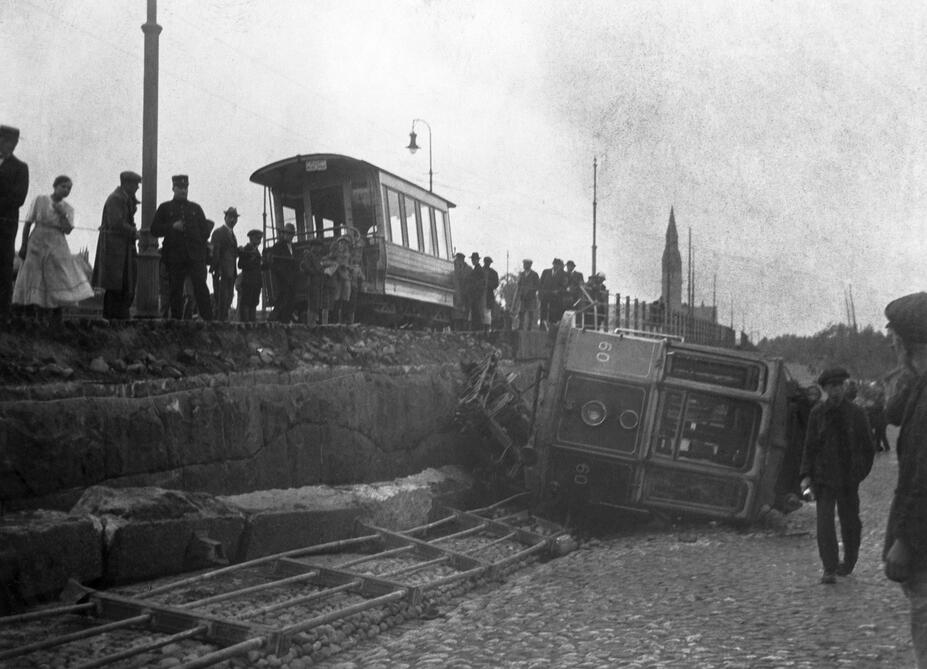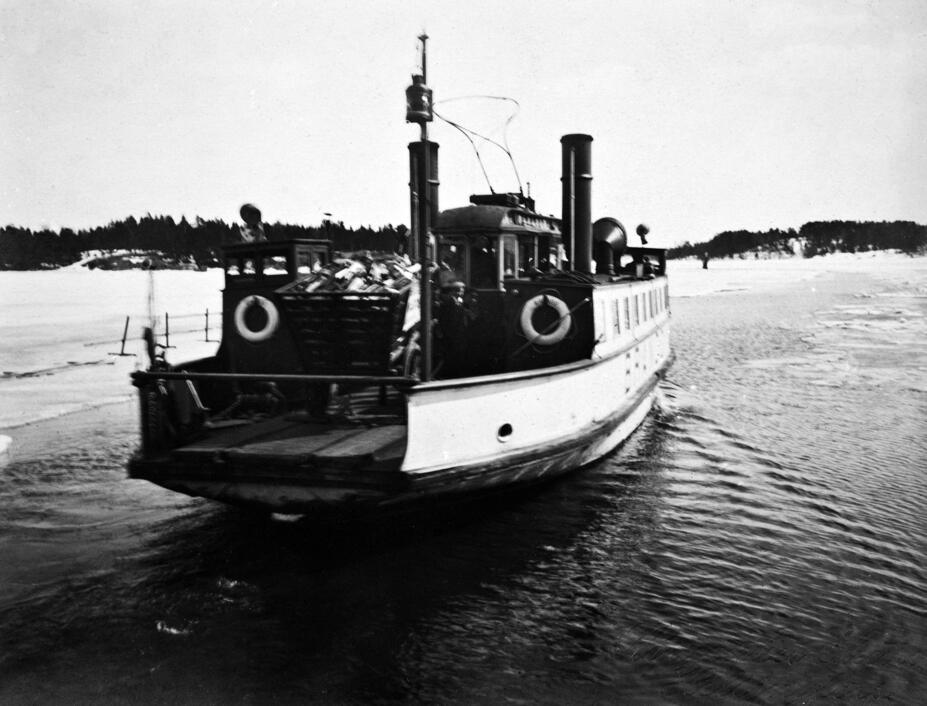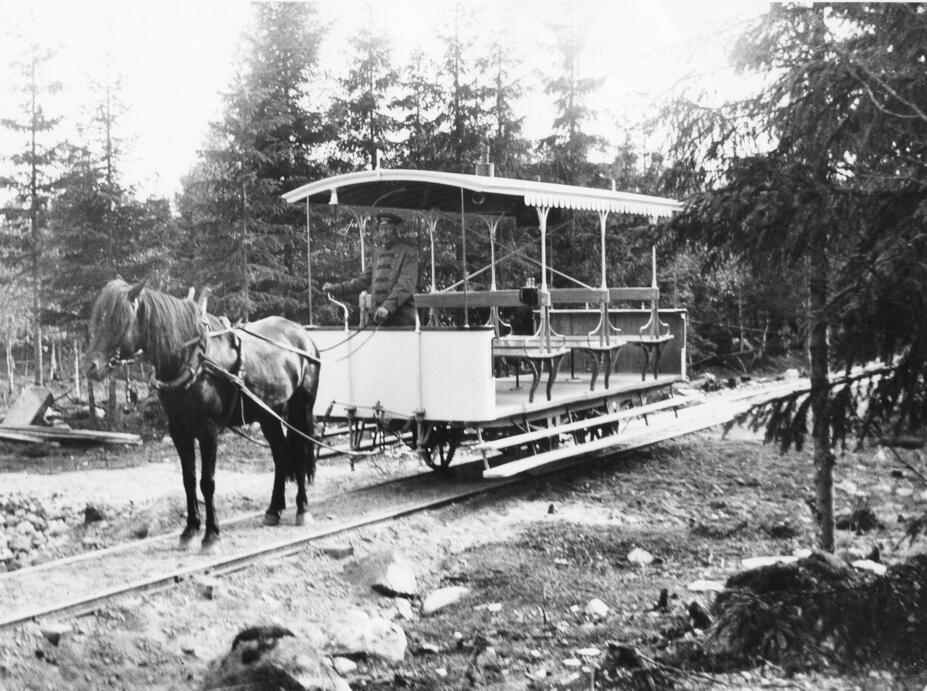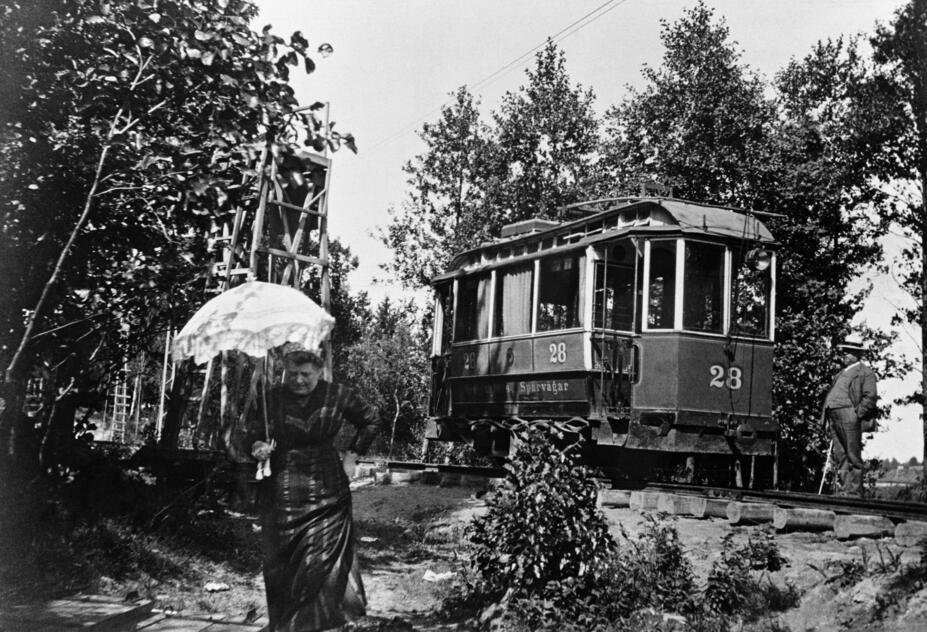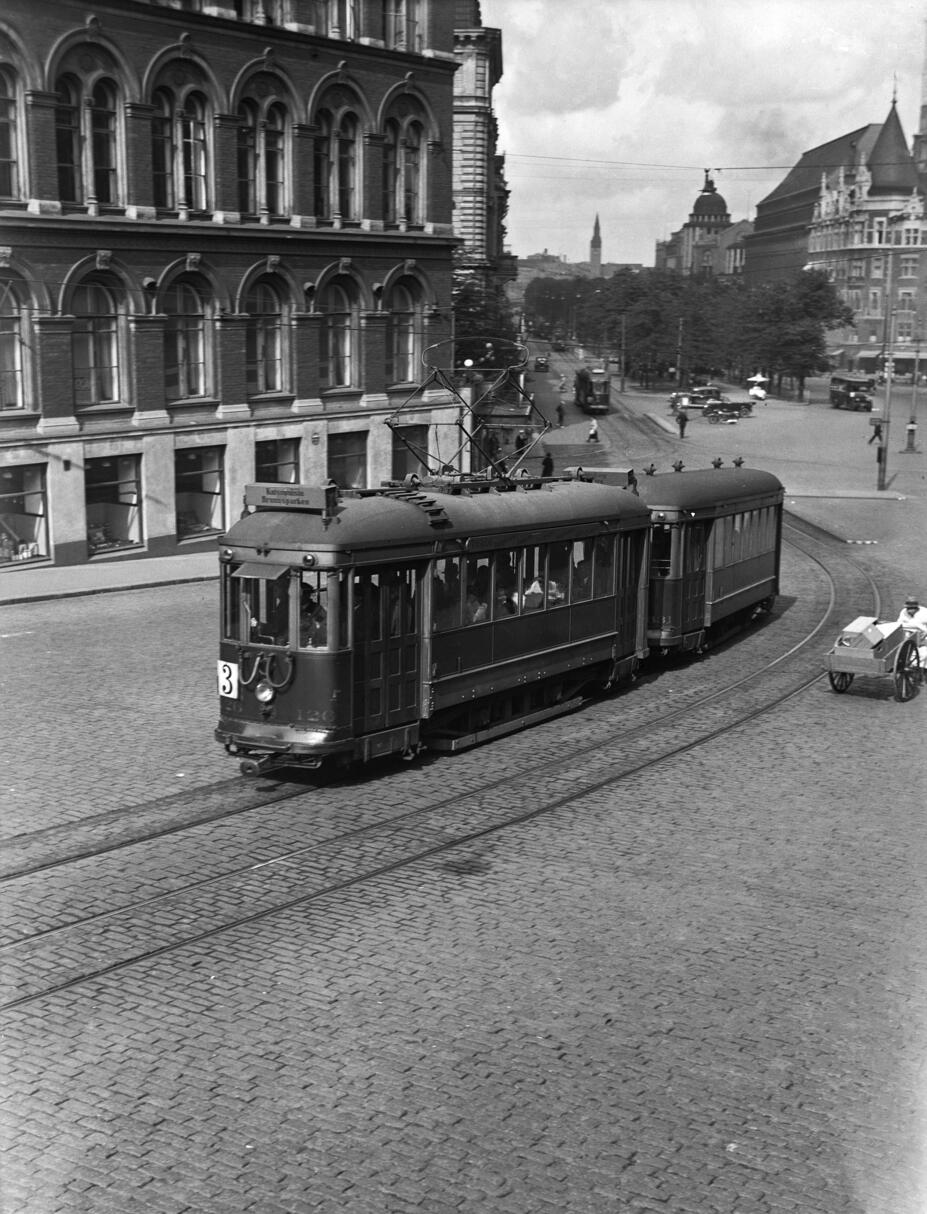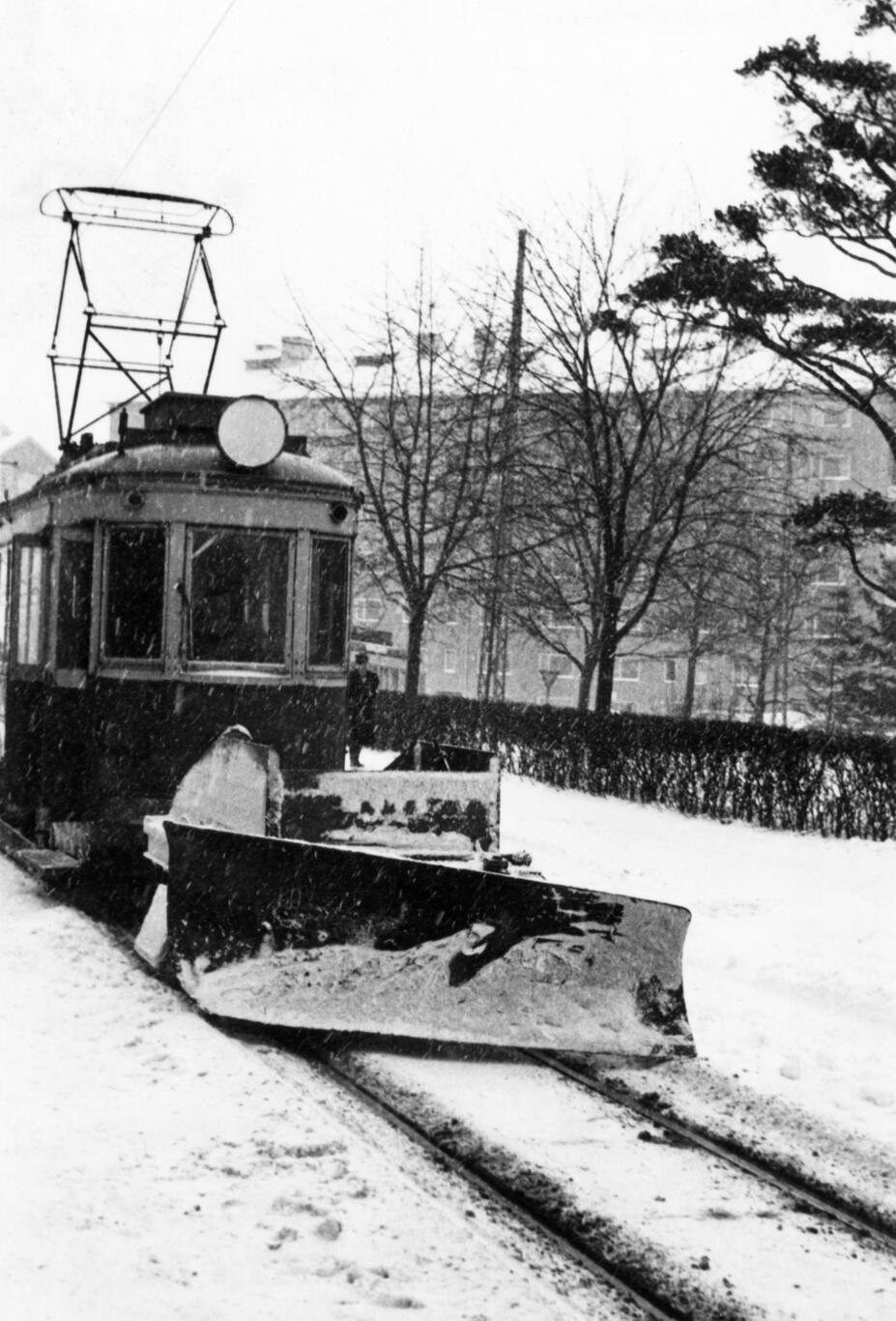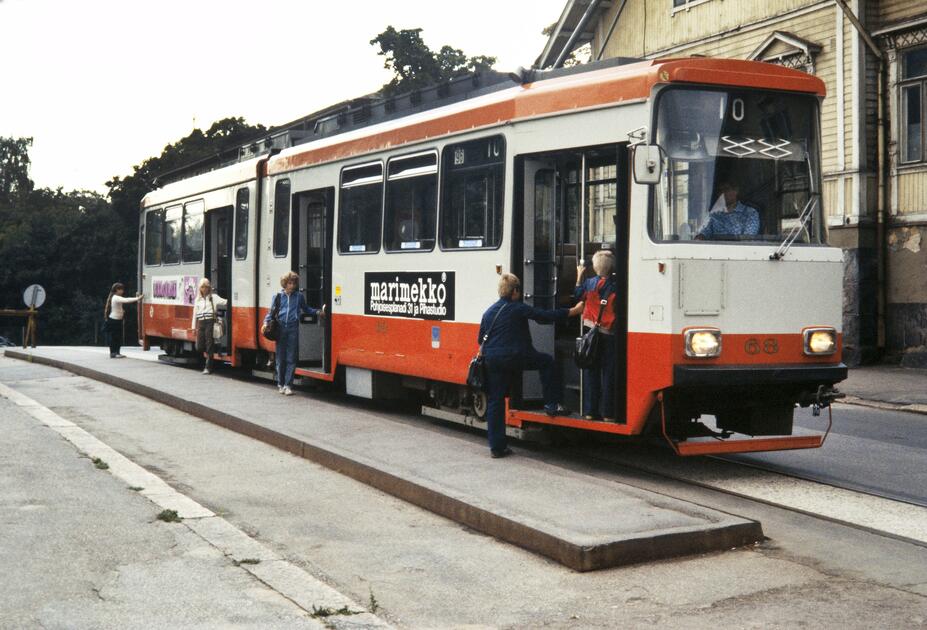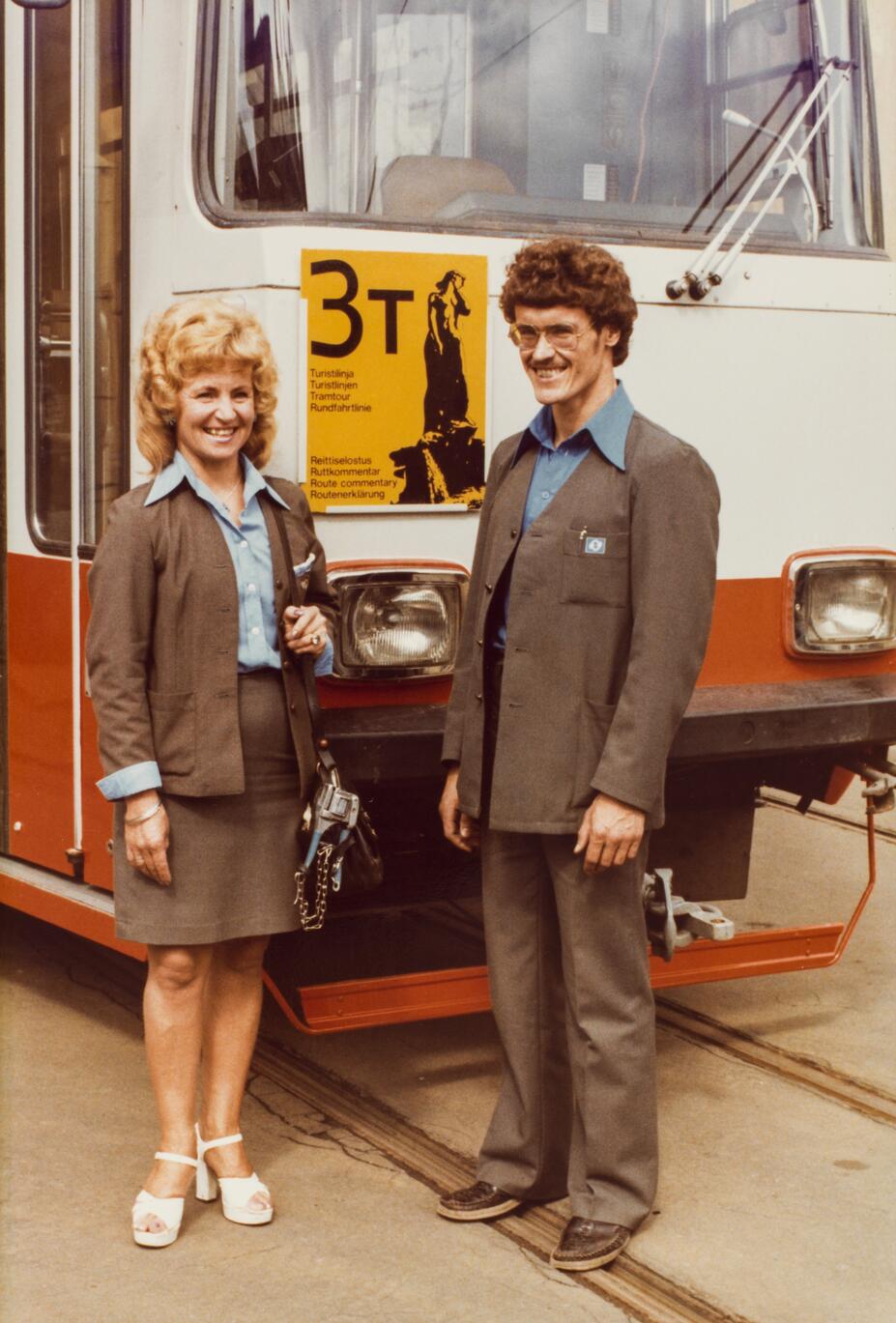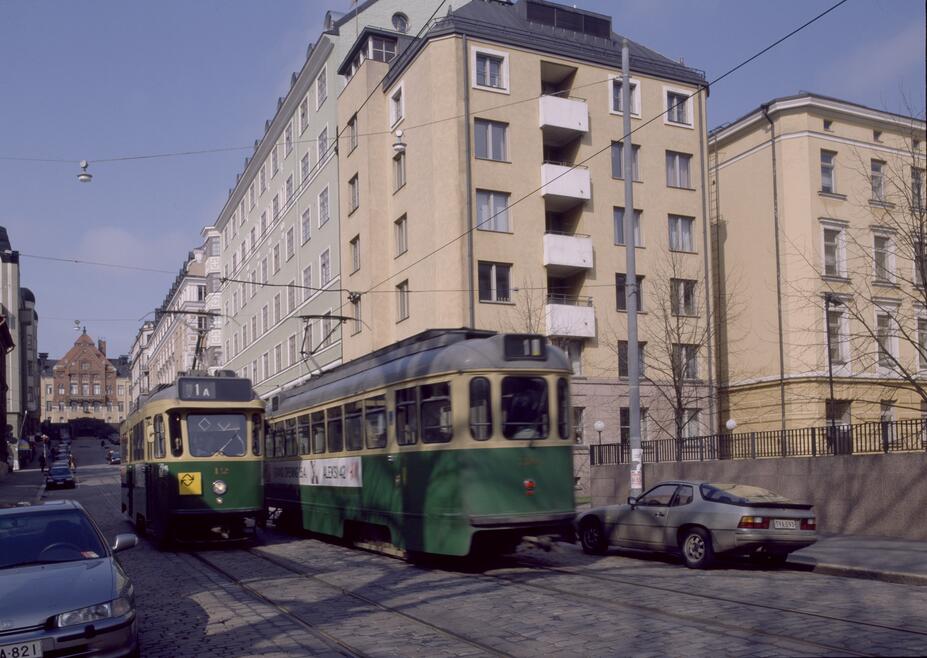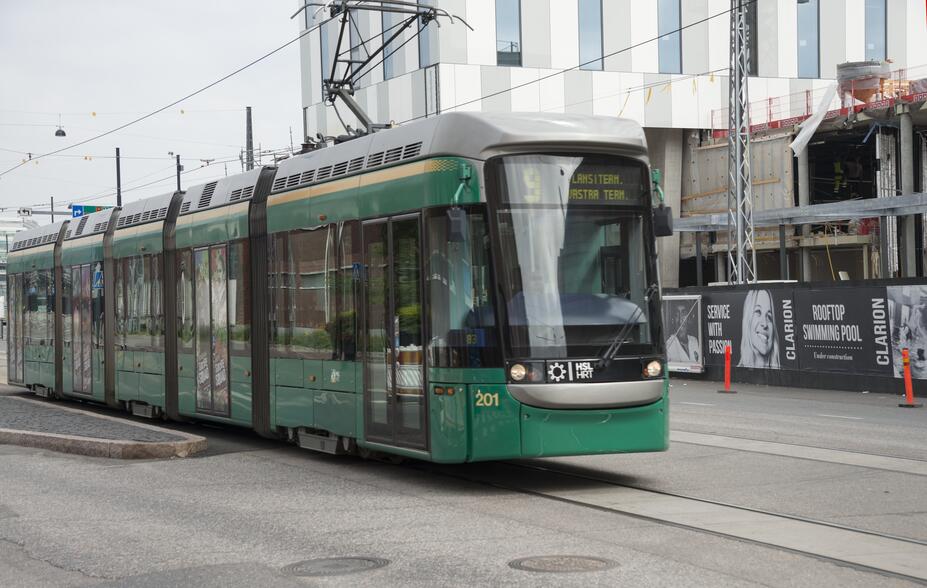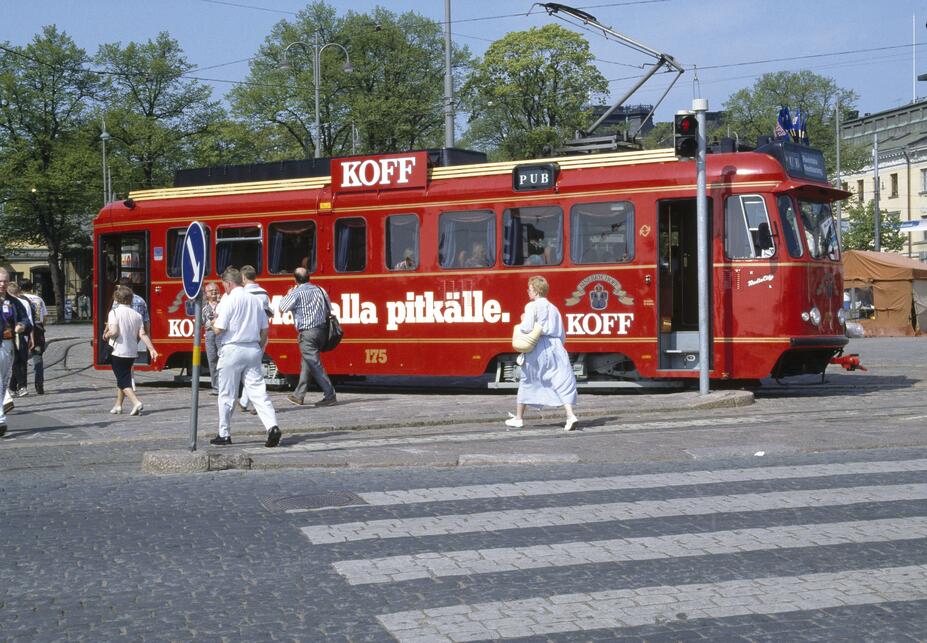Horse-drawn rail transport
During the 19th century, Helsinki was transformed from a small Swedish coastal town into a small European capital thanks to the capital city status, the university, industrialisation and commerce. To facilitate the mobility of the growing population, and in line with the European trends of the time, tram tracks suitable for urban conditions were also planned for Helsinki. Tram lines had previously been opened in the United Kingdom, Sweden and Denmark, for example. They combined the best of trains and horse-drawn carriages: the tracks made for smoother and easier progress. On the other hand, being smaller than a train, the carriage was vital in terms of both space and the mass of the vehicle. The popularity of rail transport, both trains and trams, can also be explained by the fact that at the time, roads and even some city streets were still narrow and unpaved, and buses or automobiles with an internal combustion engine could therefore not challenge rail transport yet. Tram services started in Turku a few months earlier than in Helsinki, and in Vyborg in 1912. A tramway was also planned for Tampere in the early 20th century, but the project was shelved for over a hundred years until the city finally got its tram line in 2021.
In the 19th century, there was no city transport authority to operate the tram services, and a private company called Helsingin Raitiotie- ja Omnibus Osakeyhtiö (HRO) was in charge of the tramway. The early trams, known as ‘skuru’, were horse-drawn and operated on two routes from 1891: Sörnäinen–Kauppatori–Lapinlahti and Töölö–Kauppatori–Kaivopuisto. The end of the Töölö-Kaivopuisto line at Kaivopuisto was located in a square in front of the Helsinki Catholic Church at the beginning of Tehtaankatu.
The horses had to work hard, especially in winter. In 1954, J. E. Vihervaara, a tram driver since 1895, recalled the days before the introduction of electricity:
When it snowed often in winter, the horses were struggling. If there was even a little snow on the rails, the horses would start to sweat and shiver, and if it was cold, their nostrils would bleed. Sometimes you had to empty the carriage by force. If all the stables were full of horses, they only had to work three hours a day. But they ran for the entire hour, pulling a heavy load. When the horses got back to the stables, they were so tired that they just stood and watched for a while before starting to eat their oats.
The tram was a very popular mode of transport right from the start, and the expansion and also electrification of the tram network started almost immediately. The first electrified tram line was inaugurated in September 1900 on the Töölö-Hietalahti line.
Inexperience leads to accidents
Many people considered the new mode of transport, especially its electrified form, strange or even dangerous. Newspaper articles convey the attitude that accidents were caused especially by country bumpkins, and sometimes alcohol was also suspected as the cause. Horses were also afraid of the trams, as well as another transport novelty: the bicycle. Many accidents sadly occurred during the first years of the tram service, largely due to the fact that people and especially horses were not used to the new mode of transport.
Darkness hampered visibility, especially on Henrikinkatu or Heikinkatu (now Mannerheimintie), because the streets in Töölö were lit with dim oil lamps long after the rest of the city had switched to more efficient gas lamps. Electric street lights started to replace gas lights as early as the end of the 19th century.
A growing city, tracks also to the suburbs
Helsinki continued to grow in the 20th century. Small residential areas called “villa towns” or “densely populated communities” started to form outside the city boundaries of the time in what was Helsingin maalaiskunta (Helsinki rural municipality). Some of these communities split away from Helsingin maalaiskunta, giving Helsinki four new neighbouring municipalities: the municipality of Huopalahti (which included Lauttasaari and Munkkiniemi), Haaga township, the municipality of Kulosaari and the municipality of Oulunkylä. At this point, the current East and North Helsinki were still part of Helsingin maalaiskunta.
Tram services were quickly extended to these suburbs. A horse-drawn tram operated on the island of Lauttasaari in the 1910s, but the line was closed after only a few years. At the time, it was the last of Finland’s horse-drawn tram lines. No electric tramway to Lauttasaari was built even though Lauttasaari, together with Munkkiniemi, became an independent municipality called Huopalahti. In 1946, the municipality of Huopalahti was annexed to Helsinki, but public transport to Lauttasaari only consisted of buses. Lauttasaari had to wait for rail traffic well into the 21st century when Länsimetro was opened and two stations were placed there: Lauttasaari and Koivusaari.
A tramway to Munkkiniemi was built by the Stenius company, running from the Old Student House to Ramsaynta (the Meilahdentie intersection), i.e. roughly along the route of the current tram line 4. Regular services started in 1915. A tramway of the Stenius company, which was taken over by the HRO in the 1920s, ran to the Haaga township, near the current tunnel going under the railroad at Tunnelitie. The tram ran to Haaga until the 1950s, at which time the line was shortened to end at Pikku-Huopalahti.
A tramway was also built to the island of Kulosaari, the fourth densely populated community in Helsingin maalaiskunta. It was in use between 1910 and 1951. The Kulosaari tram was electrified from the start, and in keeping with the style of the affluent area, the trams were fitted with teak cladding and real crystal lamps like boats. There was no bridge to the west of Kulosaari at the time, so the tram crossed the strait on a ferry before continuing towards the Market Square. The tracks continued on the opposite bank also on the Kulosaari side, and the tram made a turn at the end of what is now Kulosaarentie. Kulosaari became an independent municipality but was annexed to the city despite strong opposition from the people living there, especially former president Ståhlberg. The Kulosaari tramway was closed in 1951, and the island was without rail transport up until the 1980s when the metro was opened.
As a tramway had been built to the municipality of Huopalahti, the Haaga township and the municipality of Kulosaari in the early 20th century, the only neighbouring municipalities of Helsinki without a tramway were Helsingin maalaiskunta (currently Vantaa) and the municipality of Oulunkylä. Naturally, both Oulunkylä and many parts of Helsingin maalaiskunta were along the railway line. This means that before 1946, Espoo was not a neighbouring municipality of Helsinki, because either Helsingin maalaiskunta, the municipality of Huopalahti or the Haaga township separated it from Helsinki. Like the metro, the tram did not come to Espoo until the 21st century. The construction of Jokeri Light Rail from Itäkeskus to Keilaniemi in Espoo started in 2019 and is expected to be completed in 2024.
Trams are part of Helsinki
Trams became increasingly popular in the first decades of the 20th century. During and after the Second World War, trams played a particularly important role in public transport, as fuel was scarce and many buses had been converted into lorries to be used by the army. On the other hand, the operation of trams was sometimes hampered by the lack of electricity. Nevertheless, 150 million tram journeys were made in 1945, compared to only 7.5 million bus journeys.
A major annexation was realised in 1946 when key parts of Helsingin maalaiskunta were joined to the City of Helsinki (including the surroundings of what is now Malmi and Herttoniemi). The four small municipalities of Haaga, Huopalahti, Oulunkylä and Kulosaari were also annexed. The plan was to use trams for transport between the annexed areas and the city centre, especially “express tramways”, which would have fewer stops and tracks separated from the road. However, the idea of realising public transport with the metro on the one hand and commuter trains and buses on the other was soon introduced. Continuously increasing car ownership and the construction of roads, including motorways, was also seen as a solution for the future.
In Turku, this development led to the closing of all tram lines in the 1970s. This was not the case in Helsinki, but trams were only retained in the city centre and, of the annexed areas, Munkkiniemi. After Vyborg was lost to the Soviet Union, Helsinki was the only tram city in Finland for decades, and trams became a form of transport that reflected the soul of Helsinki. The beloved tram is called by many names in Helsinki.
Trams were constantly being developed, first into multi-part articulated carriages and then into low-floor carriages. The network was also extended and new lines added, such as line 9 which started in the 2000s. After a break of almost 80 years, the Jokeri Light Rail from Itäkeskus to Keilaniemi in Espoo will make rail transport a joint service between Helsinki and its neighbouring municipality – unless Espoo is annexed to Helsinki before that...
